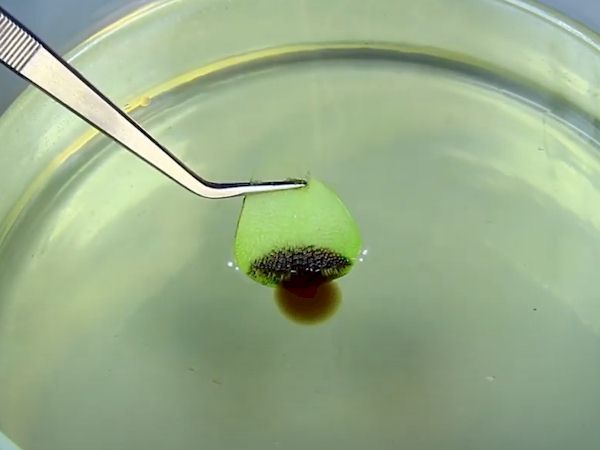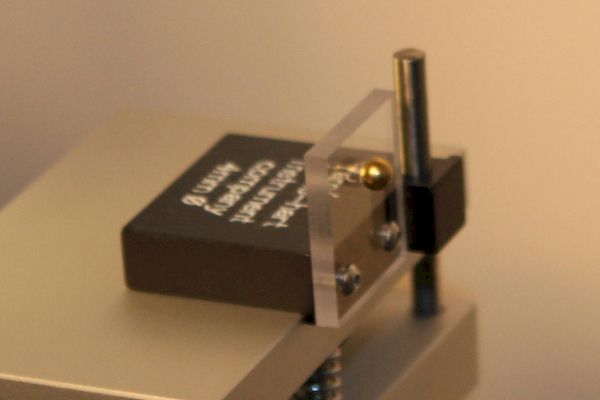|
May 2020 |
| Bioinspired Superhydrophobic Surface that Removes Oil from Water |
|
Last year in July, I introduced our
reader to the noxious and annoying Salvinia plant1.
Considered an invasive specie and threat to aquatic life, the Giant
Salvinia grows faster than most water weeds and is known to invade
ponds and waterways in record time - choking off underwater plants
and killing fish and marine life.
Alas even noxious weeds can have redeeming qualities. The inverted microscopic eggbeater structures (as shown in the SEM image below) promote a superhydrophobic surface. That is, water drops will sit on top of the asperities in a Cassie-Baxter state. However, the tips of the structure (inside the red box in the image below) are actually hydrophilic. This results in pinning which promotes an air layer between the water and the hierarchal surface structure. Salvinia-inspired surfaces have shown to reduce drag by up to 30%.2 If such bioinspired surfaces could be developed for the hulls of ocean freighters, it could translate into big savings in fuel consumption. Today we're interested in better understanding a second potentially redeeming quality of the Salvinia plant - it's capacity to remove oil from water. Researchers at the University of Bonn3 have discovered that while the Salvinia plant is superhydrophobic, it's also superoleophilic. That is, while it repels water, it also attracts oil. The video below shows how a Salvinia leaf can expertly extract oil from the surface of water.
The next step is to transfer the properties of the Salvinia plant to manmade textiles. Doing so could produce bioinspired materials that could potentially offer a superior method for skimming oil off water surfaces. In the environment, oil can wreak havoc on living organisms. Salvinia-inspired textiles offer (3) compelling advantages over traditional oil removal methods: First, unlike dispersants which are toxic and can be harmful to marine life, the Salvinia-inspired materials require and release no chemicals. Second, unlike in-situ burning which also produces toxic fumes, the Salvinia-inspired method would not only be less environmentally hostile, but the recovered oil could potentially be reused. Third, it's suggested that a bionic floating adsorber and collector could be designed that would efficiently remove oil from contaminated lake and waterway surfaces with very little manual labor.4 While the Salvinia-inspired method
detailed above may not be suitable for large-scale ocean tanker
spills, it may find a purpose in smaller lake and river cleanup
projects. How fitting then it is that a noxious weed can teach us
precisely how we can better stewards of a fragile ecosystem. |
| ramé-hart Calibration Tools |
|
The key to operating any ramé-hart
instrument at its full potential is to ensure that it's properly
calibrated. Every instrument we sell ships with a Precision
Combo Calibration Device, p/n 100-27-31.1 The calibration
routine is quite simple and only takes a minute.2 In
addition to the uncertified Precision Combo Calibration Device, we
also offer a certified version which
includes a NIST-traceable certificate, p/n 100-27-31-C.
Once an instrument has been calibrated, it's not necessary to recalibrate it often. However, we do recommend you check the calibration. This will allow you to determine if the instrument still has a valid calibration. Generally, if the new value and the stored value differ by more than 1%, it's recommended that you calibrate anew. Many of our customers will keep a log file of their calibration values. We recommend you re-calibrate after any major changes are made to the system - such as changing the lens, light source bulb, or moving the instrument to a different location. Once an instrument is calibrated, you may wish to check the instrument to ensure that it's taking valid measurements. To assist with this task, we offer a Certified Fixed Drop Calibration Reference Tool (p/n 100-27-03). This tool has (4) static sessile drops that will allow you to test your instrument to ensure that (a) it's calibrated properly and (b) that you are using a valid method for measuring. We offer a similar tool for surface tension. It's the Certified Pendant Drop Calibration Reference Tool, p/n 100-27-05.3 Note that all of the above-mentioned calibration tools along with our Certified PTFE Reference Solid, can be purchased online at our web store here: http://www.ramehart.us/calibration/. Should you have any questions about any of our calibration products or any of our products, don't hesitate to contact us. We look forward to hearing from you. 1 For more details on
this and any of our calibration tools, visit this
page. |
|
Regards,
Carl Clegg |


